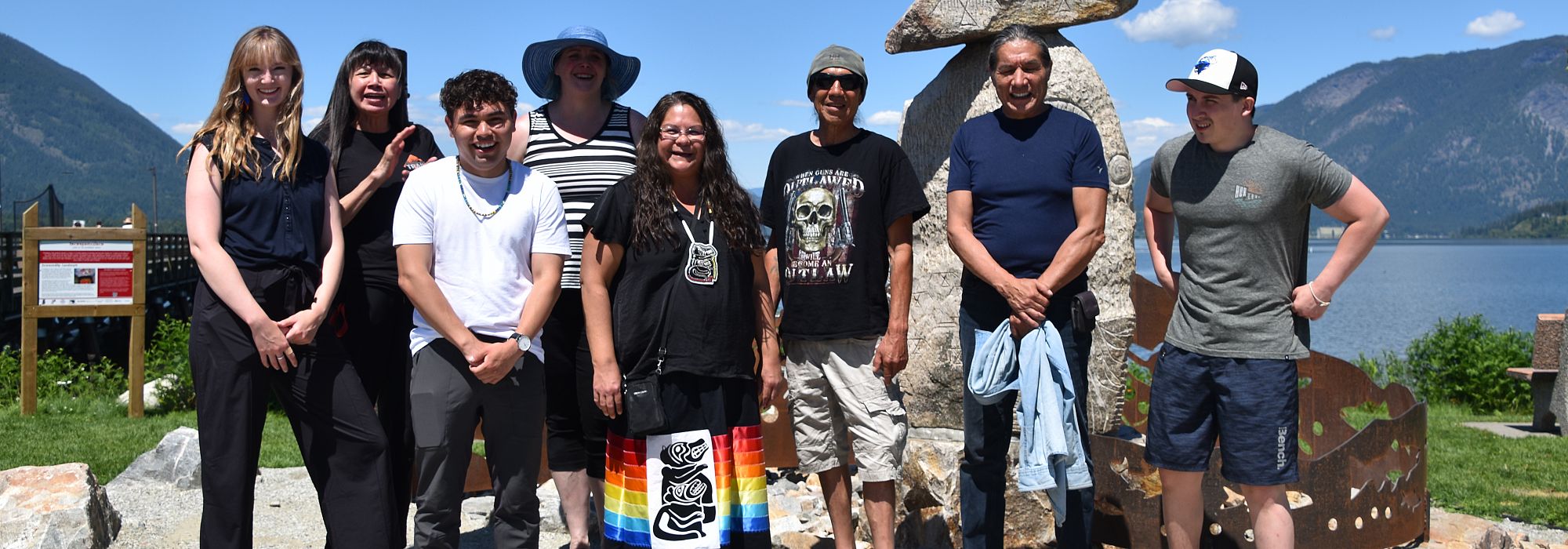#1 - Sxwetsméllp Landmark
Sxwetsméllp
Salmon ArmVoiced by: Dr. Mary Thomas
Place names transcription by Chief Atahm School
Secwépemc place names visible from Landmark site
Silketwa (Skwlāx te Secwepemcúl̓ecw) or Slleq̓etkwe (Chief Atahm school), meaning Wide Water
Tappen Bay or North Bay
Voiced by Dr. Mary Thomas, Transcription 1) Skwlāx te Secwepemcúl̓ecw, 2) Chief Atahm SchoolSlehets̓ellcwícwel̓t (Baby Otter)
Kault Hill
Voiced by Dr. Mary Thomas, Transcription by Chief Atahm SchoolCkek̓etsín
Mouth of Salmon River
Voiced by Dr. Mary Thomas, Transcription by Chief Atahm SchoolKwelésce7 (Kela7scen)
Mount Ida
Voiced by Dr. Mary Thomas, Transcription by Chief Atahm SchoolKwellk̓émt (underneath)
Bastion Mountain
Voiced by Dr. Mary Thomas, transcribed by Lucy William and Donna AntoineNecelclánk (Steep Hillside)
Fly Hills
Voiced by Lucy WilliamLehets̓éllcw (Otter Mountain or Otter House)
Tappen Mountain
Voiced by Dr. Mary Thomas, Transcription by Chief Atahm SchoolTsecwelcwéqs
Sandy Point
Voiced by Dr. Mary Thomas, Transcription by Chief Atahm SchoolXgwelcwéllcw (Fox's Home)
Engineers Point
Voiced by Dr. Mary Thomas, Transcription by Chief Atahm SchoolView All Landmarks on Map
About the Sxwetsméllp Landmark Sculpture
Sxwetsméllp Landmark Artists
Rod Tomma, Tilkotmes Tomma, Eric Kutschker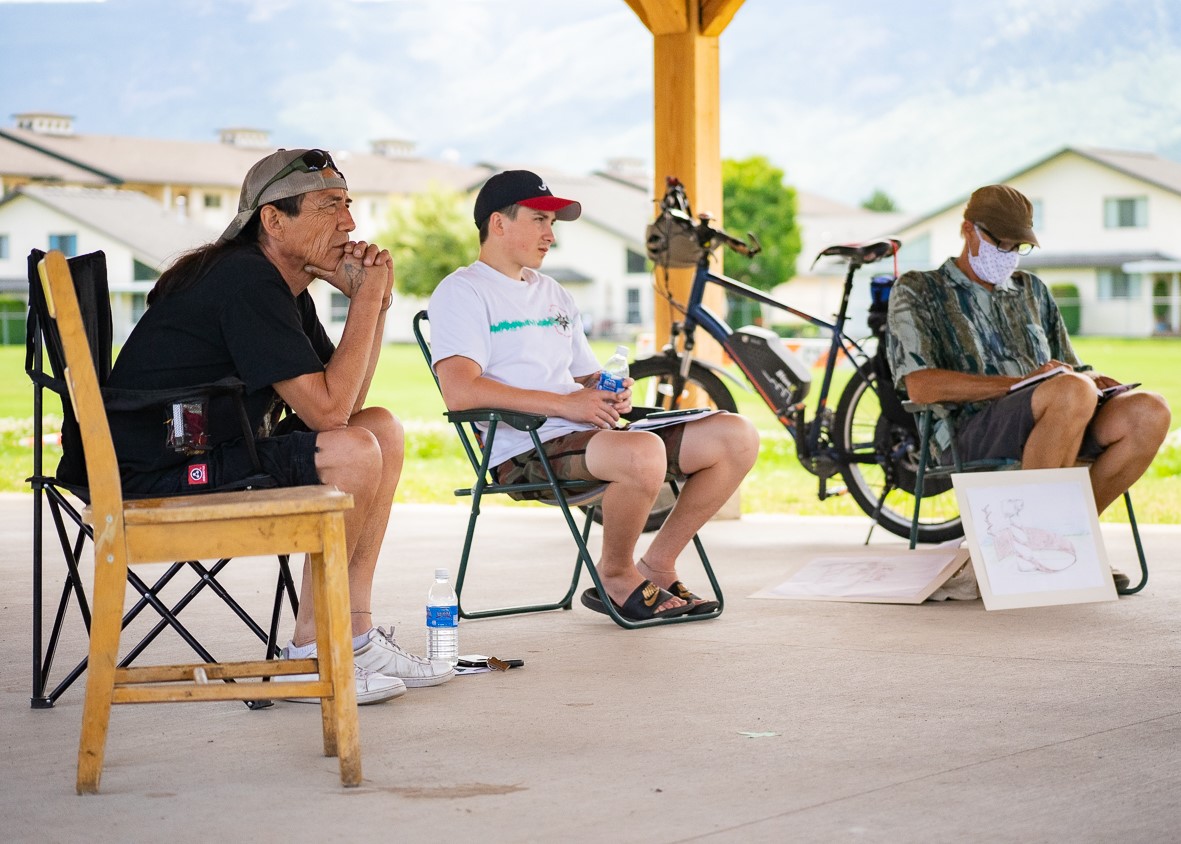
The Sxwetsméllp Landmark was created by Secwépemc artists Rod Tomma and Tilkotmes Tomma and settler artist Eric Kutschker. The rose granite sculpture represents Coyote rock formations created by Sek'lép, Sk'lap, or Senxúxwlecw (Coyote) throughout Secwepemcúl'ecw. The metal sculpture highlights oral histories shared by the Secwépemc Landmarks Elders Advisory Group, representing the salmon, whitefish and sxúsem berry as important traditional food sources for Secwepemc people. The flow of images are set among the surrounding mountains silhouettes, and lead to the birch tree with its distinctive bark pattern.
Sxwetsméllp stems from the verb "xwítses: To cut (grass)”, referring to the cutting of tule grass for mats. This place name refers to the area around the confluence of the Salmon River and Shuswap Lake. Sxúse or sxúsa (soopolallie berries), t'nís (highbush cranberries), tule, and many other plants are cultivated by Secwépemc families here. Fishing weirs were also built along the Salmon River for selectively harvesting salmon and taking only what was needed; leaving the rest to continue their journey.
The establishment of the Indian Reserve system, and laws restricting Secwépemc people from leaving reserves or accessing culturally significant foods, fractured many relationships between Secwépemc communities, families, and their lands and waters. Diversions to the Salmon River for agriculture, railroads, and other developments altered the ecology of the Salmon River Delta, and impacts habitat availability for many culturally significant plants and salmon, who are considered to be relatives of the Secwépemc. The place name Sxwetsméllp teaches about this landscape change and restoration, as well as the continued importance of this place to past, present, and future generations of Secwépemc people and the many plants, animals, and fish who share this landscape.
This sculpture location has been blessed by Secwépemc Elders. It is passed down in Secwépemc oral tradition that the land is to be respected and is sacred. Oral tradition teaches one to ask for permission to walk in places on the land, and to act respectfully towards plant and animal relatives while you are there. Please act with caution and respect around these monuments and grandmother/grandfather rocks.
Note: The Cstélnec, Splatsínac, Sk'etsinec, and Skwlax te Secwépemc people are part of the larger Secwépemc Nation and therefore have rights and responsibilities to the cultural knowledges and symbols included in this project. Any Intellectual Property Rights associated with these Secwépemc cultural knowledges and symbols inherently belong to the Secwépemc people and cannot be copied or adapted without permission. In addition, no photographs, images, or art portraying the sculptures themselves should be used for commercial purposes without permission
Rod Tomma, Tilkotmes Tomma, and Eric Kutschker, Sculpture Artists. Photo by Jacob Sutra Brett.
Neskonlith Elder Gerry Thomas and Eric Kutschker, Metalwork Artist. Photo by Jacob Sutra Brett.
Splatsín Elder Julianna Alexander and Project Coordinator Libby Chisholm. Photo by Jacob Sutra Brett.
Micky Tomma (Research Assistant) and Dale Tomma, Little Shuswap Lake Band. Photo Credit: Martha Wickett, Salmon Arm Observer.
Some members of the Secwepemc Lakes Elders Advisory Committee. Photo Credit: Martha Wickett, Salmon Arm Observer
Project Lead, Tk'wemi'ple7 Shelley Witzky. Photo Credit: Martha Wickett, Salmon Arm Observer
Sculpture Unveiling. Photo by Martha Wickett, Salmon Arm Observer.
Artists Ron Tomma, Rod Tomma, and Tilkotmes Tomma. Photo Credit: Martha Wickett,Salmon Arm Observer
STA Executive Director Jen Bellhouse, Project Lead Tk'wemi'ple7 Shelley Witzky, Metalwork Artist Eric Kutschker. Photo Credit: Martha Wickett, Salmon Arm Observer
Members of the Secwepemc Landmarks Project Team (some absent). Photo Credit: Martha Wickett, Salmon Arm Observer
Viewing portals. Photo by Libby Chisholm.
Sxúse (soopolallie berry). Photo Credit: Tess Tomma
Secwépemc Landmarks Project Background
Secwépemc (“the spread-out people”), a Nation of 32 Interior Salishan communities that have been divided into 17 bands by the Indian Act, are 12,000 people strong and growing. Before contact with Europeans, the original population is estimated at 25,000 people, drastically reduced to 7,000 due to the 1862 smallpox epidemic. Secwépemc territory spans approximately 180,000 squared kilometres (112,000 squared miles) which includes the headwaters of the two largest river systems in British Columbia; the Columbia and Fraser River valleys, and extends south to the Arrow Lakes. Secwépemc have occupied their territory, Secwepemcúl̓ecw, for over 10,000 years and have never signed away, ceded or sold their land or territory.
The Secwépemc Landmarks Project is a Secwépemc-led arts project that supports Secwepemctsín (Secwépemc language) learning and creates awareness of Secwépemc oral histories, language, and laws in Secwepemcúl̓ecw. The project features close to 100 trailhead posts carved by close to 200 youth from Secwépemc Child and Family Services, Chief Atahm School, Shihiya, and School District No. 83 in 2021 and 2022; and 16 Secwépemc Landmark sculptures and interpretive panels that feature Secwépemc oral histories, place names, culture and stories throughout the Shuswap Lakes region of Secwepemcúl'ecw. The trailhead posts and landmarks are a deep reminder of the presence and relationships past, present, and future generations of Secwépemc continue to have to the lands and waters in Secwepemcúl̓ecw.
Trailhead posts were carved by youth under the instruction of Secwépemc storyteller Kenthen Thomas and Secwépemc carvers Hop You and Vern Clemah. The students’ carvings tell the stsptékwle (oral history) of “Coyote and the Salmon”, which Secwépemc storyteller Kenthen Thomas describes as telling the story of how Sek̓lep (Coyote) brought salmon to the Sxwetsméllp (Salmon Arm) area.
Sculpture locations have been blessed by Secwépemc Elders. It is passed down in Secwépemc oral tradition that the land is to be respected and is sacred. Oral tradition teaches us to ask for permission to walk in places on the land and to act respectfully towards plant and animal relatives while we are there. Please act with caution and respect around these monuments and grandmother/grandfather rocks.
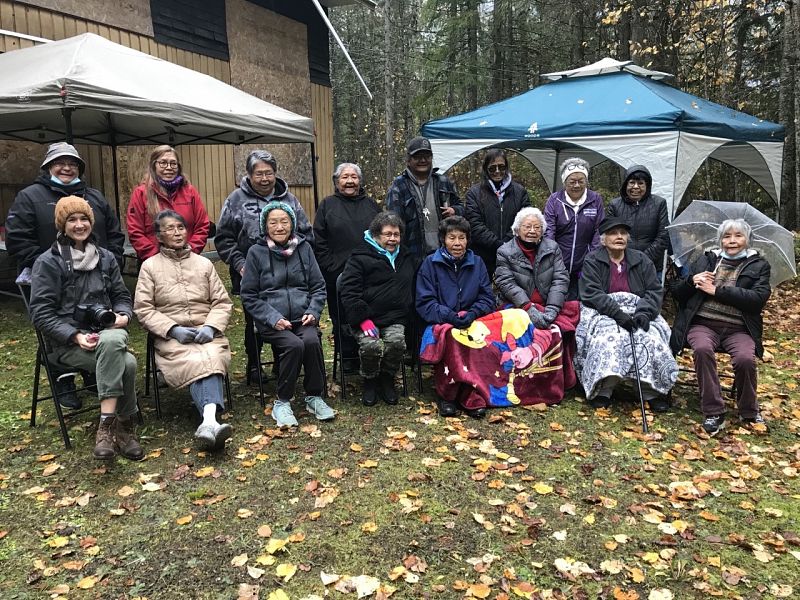
Malakwa Site Visit.
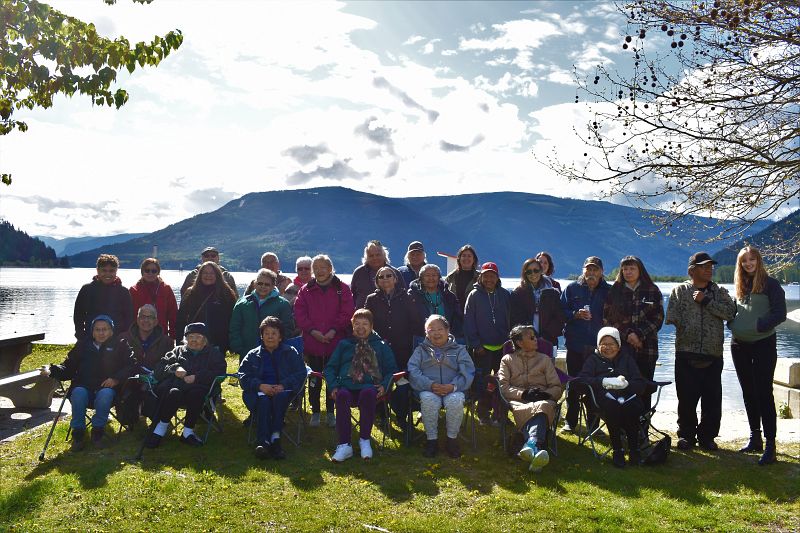
Sekmáws site visit. Photo by Ash Simpson, Splatsín Title and Rights.

Sekmáws site visit. Photo by Ash Simpson, Splatsín Title and Rights.
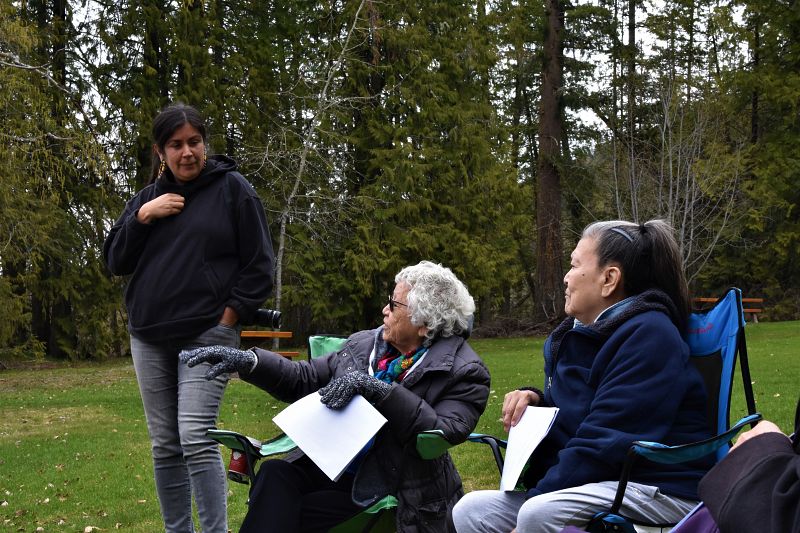
Mara Lake site visit, Artist Tania Willard (Neskonlith) with Elders Ethel and Juanita Thomas.. Photo by Ash Simpson, Splatsín Title and Rights.
.JPG)
Initial Project Concept, Tk'wemi'ple7 Shelley Witzky and Jacob Sutra Brett. Photo by Martha Wickett, Salmon Arm Observer.

Splatsín carver Hop You with SMS Youth, Trailhead Post Carving workshop.
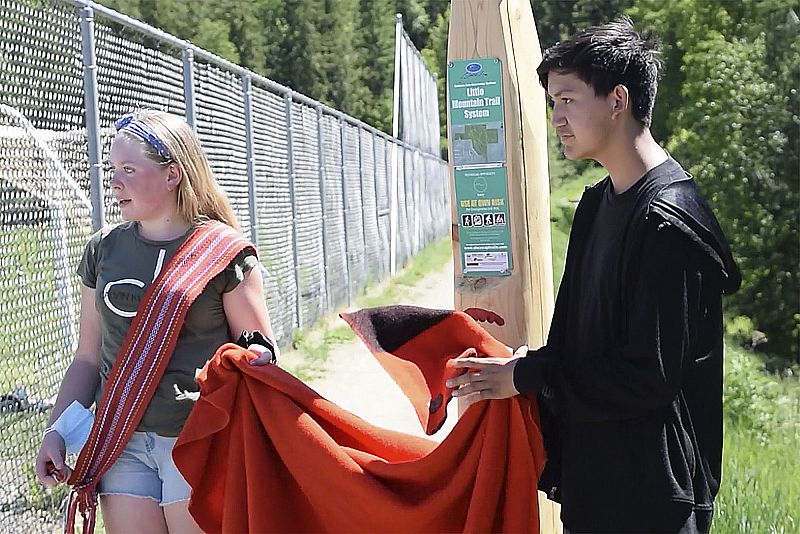
The first trailhead post being unveiled by Shuswap Middle School students Darah Thurston and Jeremiah Vergera. Photo by Martha Wickett, Salmon Arm Observer.
Acknowledgements
The Secwépemc Landmarks project is led by Adams Lake Band, Neskonlith Band, Skwlāx te Secwepemcúl̓ecw, and Splatsín, with administrative support from the Shuswap Trail Alliance. The Secwépemc Landmarks Project Team would like to acknowledge with heartfelt gratitude the many community members and sponsors who have made this project possible.
The Secwepemctsín place name audio recordings are by Lucy William, Donna Antoine, and the late Neskonlith Elder Dr. Mary Thomas, whose work as a knowledge keeper and environmentalist inspired many about Secwépemc values of knucwentwécw (helping one another) to learn about and protect Secwépemc traditional plants for future generations. Secwepemctsín language revisions for the place names transcriptions and signage were completed by the Cstélnec Elders at Chief Atahm School and Donna Antoine (Splatsín dialect).
The Secwépemc Lakes Elders Advisory Committee, made up of Elders from Adams Lake Band, Neskonlith Band, Splatsín, and Little Shuswap Lake Band, guided this project. Each Landmark sculpture represents oral histories connected to each place. The Project Team would like to acknowledge the contributions and guidance of all Elders attending the Secwépemc Lakes Advisory Committee meetings.
The Project Team is made up of Shelley Witzky-Spemulecw (Project Manager), Libby Chisholm (Project Coordinator), Dorry William (Elders Coordinator), Ash Simpson (Splatsin Title and Rights), and previous contributors include Micky Tomma (Research Assistant), and Qwelmínte Secwépemc interns Devin Doss and Mackenzie Creasser. Landmark Artists include Tania Willard, Kel-c Jules, Rod Tomma, Tilkotmes Tomma, the late Mike Peters, Eric Kutschker, David Jacob Harder, Shayne Hunt, Hop You, Tony Antoine, Vern Clemah, Jules Arnouse, Rick, and Kenthen Thomas (storyteller).
The Secwépemc Landmarks project is funded in part by Adams Lake Band, Neskonlith Band, Little Shuswap Lake Band, Splatsín, the Shuswap Trail Alliance, the Province of British Columbia, Shuswap Tourism, the City of Salmon Arm, SASCU, Hard Rock Granite, Heritage BC through the Heritage Legacy Fund, as well as through in-kind donors such as AIM Roads, the Salmon Arm Arts Centre, School District No. 83, Switzmalph Cultural Society, Len Lega, and Browne Johnson Land Surveyors. Kukstsémc also to staff and students from Shihiya, Chief Atahm, Jackson, Sullivan, SMS, and South Canoe schools for their work on the Secwépemc Landmarks trailhead posts.
Exploring Respectfully
Shuswap Trails
Fostering a healthy, engaged community in the Shuswap Region – economic/environmental/social – through well designed, maintained, and promoted trails connecting people, culture, and landscape

